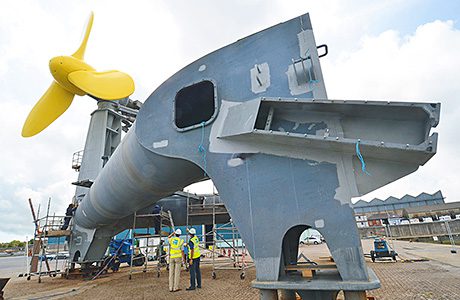
WALES’ first full-scale tidal energy generator was unveiled on 7 August at Pembroke Port by The First Minister of Wales, Carwyn Jones.
The DeltaStream device developed by tidal stream technology company Tidal Energy Ltd (TEL) was to be installed in Ramsey Sound, Pembrokeshire, following its unveiling – and is said to be amongst the world’s first grid-connected demonstration devices to generate green, sustainable and predictable tidal power.
It is the first private marine project to be fully developed in Wales, having secured all the required planning and environmental consents together with a lease agreement from The Crown Estate. The company has also worked with contractors to install the necessary infrastructure to support what will be the first grid-connected freestanding tidal turbine in Wales.
Unlike other tidal designs currently being developed, the multiple patented DeltaStream device combines an innovative freestanding triangular base design with a state-of-the-art hydraulics system, which ensures the turbine freely turns to capture the best tidal flow and maximise power generation. The gravitational pull anchors the device in place, eliminating the need for costly drilling into the seabed and ensuring low installation and maintenance costs relative to the electricity it generates.
Tidal Energy Ltd’s DeltaStream 400kW demonstration device, which weighs 150 tonnes and with a frame 16m long by 20m high, also includes a number of design features to minimise any potential impact on the surrounding environment. Consequently, DeltaStream is the first project to receive precautionary ‘deploy and monitor’ environmental consent in a designated Marine Special Area of Conservation.
Managing Director of Tidal Energy Ltd, Martin Murphy said: “This is a significant milestone for us as a company and for the industry as a whole. We have achieved a number of firsts with this project, including those relating to the environmental consents, the grid connection and the installation process – where the turbine and foundation are installed together.
“The imminent launch of DeltaStream, and the supply chain that now exists as a consequence of its development, marks the birth of the tidal industry in Wales. We remain committed to leading the expansion of this industry and to the creation of green jobs by building on the wealth of expertise present in the UK and the country’s plentiful resources.”
EU funds worth £8m delivered through the Welsh Government have been invested in the project, with match funding from majority shareholder Welsh renewable energy company Eco2 Ltd.
The DeltaStream project marks the first step in the delivery of the Welsh Government’s March 2014 Plan for its Low Carbon Transition Strategy in marine renewable generation.
Commenting on the project, the First Minister of Wales, Carwyn Jones said:
“I’m delighted that Wales’ first full scale tidal stream energy generator has been supported with almost £8million from the European Regional Development Fund. This is a landmark project for Wales, which will not only help us to meet our sustainable energy ambitions, but will also provide significant opportunities for local people and businesses.”
Following a 12 month testing period, TEL will join forces with Eco2 Ltd to install up to nine DeltaStream devices off St Davids Head in Pembrokeshire. These installations will form a 10MW DeltaStream commercial array, and generate enough power for approximately 10,000 homes.
Dr David Williams, Chief Executive of Eco2 Ltd said: “The St Davids Head project will serve to further prove the commercial viability of DeltaStream and marine renewable energy as a whole. The device has excellent export potential for deployment in high energy tidal sites around the world, and we intend to harness this tidal potential.”
DECC estimates the UK has around 50% of Europe’s tidal energy resource and could meet up to 20% of its electricity demand using wave and tidal technology. Tidal power is sustainable, efficient and, importantly, it is predictable, meaning it has the potential to play a major role in providing lasting reliable energy security.







